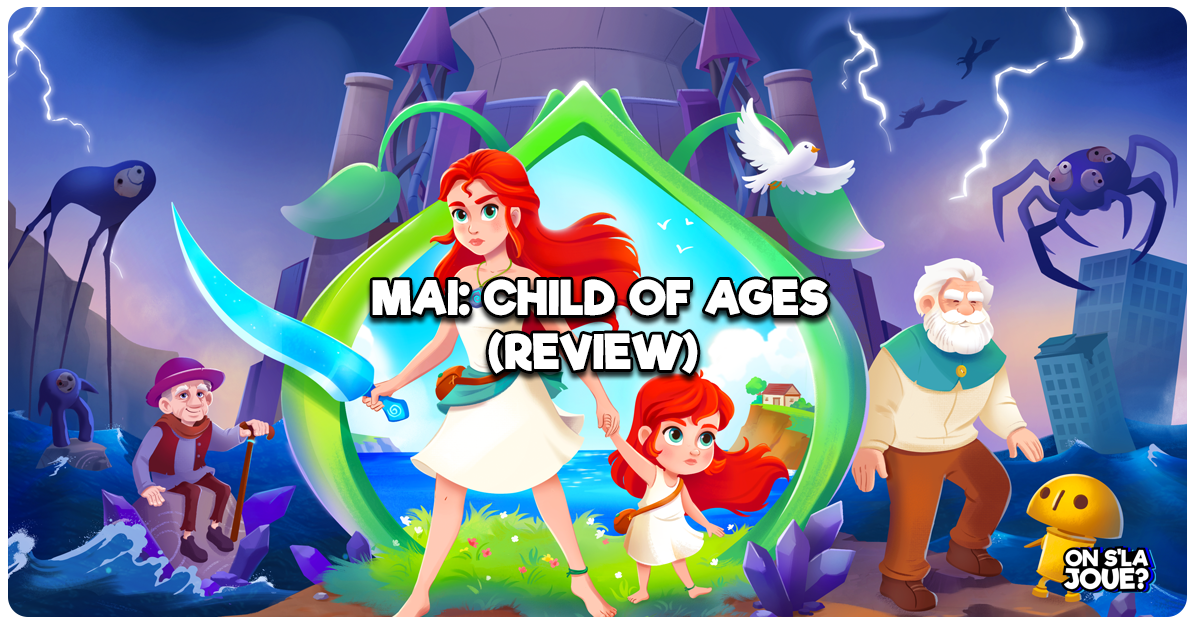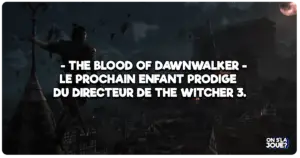
Mai: Child of Ages (Review)


Context
Developed and published by Chubby Pixel, Mai: Child of Ages released in September 2025 for PC and multiple consoles, including Steam, GOG, and the Nintendo Switch. Framed as an exploration-based adventure, the game channels clear inspiration from Legend of Zelda’s structure but reinterprets it through a focus on time manipulation and environmental storytelling. Its core mechanic—the Sacred Plant, or Uroboro Stone—lets players shift between past and future versions of the same landscapes, turning each area into a layered puzzle that evolves with every temporal transition.
Rather than chasing intensity, Mai finds its identity in rhythm and contemplation. Combat plays a supporting role, adding texture to exploration without overshadowing the puzzle design. The sense of progression is more reflective than adrenaline-driven, with each dungeon or ruin serving as a quiet study of cause and effect across eras.
I would also like to thank Chubby Pixel for providing the key used to test the game. This key was obtained through a collaboration with Keymailer.
Graphics
Mai: Child of Ages captivates with its unique painterly art style that prioritizes atmosphere and emotional storytelling over high-end graphics. The minimalist visuals, shifting dramatically between vibrant and desolate eras, effectively highlight the game’s time-travel core. While charming character designs and rich environmental contrasts strengthen immersion, technical flaws such as inconsistent animation and rough textures sometimes undermine the polish. Despite these limitations, the graphics form a vital part of the game’s identity, successfully blending style and narrative to create a memorable, evocative experience.
Gameplay
At its core, the game makes players manipulate the Sacred Plant, the Uroboro Stone, to traverse past and future versions of locations, unlocking paths and solving puzzles by observing how the world changes over time—bridges existing in one era, ruins in another. This mechanic stands as the game’s standout feature, encouraging curiosity and strategic thinking while reinterpreting familiar spaces through temporal shifts.
The platforming challenges emphasize observation and timing, rewarding players who carefully study the environments through their evolving states. The game fosters a rhythm of discovery, where revisiting areas with new abilities or perspectives encourages re-exploration and deeper engagement. This exploration is enriched by a Metroidvania-style progression, where unlocking new skills expands both traversal options and puzzle complexity.
Combat in the game is light and accessible, featuring basic combos, dodge and counter mechanics, and occasional arena-style encounters. While sufficient for casual engagement, combat has been criticized for lacking depth and polish, occasionally feeling repetitive and less refined compared to the game’s exploration and puzzle systems. This disparity sometimes affects pacing, as combat segments can interrupt the otherwise contemplative flow of exploration.
Puzzle design complements the time-travel theme effectively, though some late-game puzzles reuse similar concepts, which may reduce engagement for players seeking constant innovation. Despite this, the integration of time mechanics into both gameplay and story creates a coherent and immersive experience.
Visually, the game employs a painterly, minimalist art style with soft pastel tones that shift dramatically between vibrant and bleak eras, reinforcing the narrative’s themes of change and memory. While technically modest and occasionally hampered by rough animations, the graphics excel in mood and thematic cohesion, lending the world emotional weight and charm.
Overall, Mai: Child of Ages excels as a thoughtful, atmosphere-driven adventure that rewards exploration and time-based puzzle-solving. It stands out for its inventive use of temporal mechanics and evocative art direction but may feel less satisfying for players seeking deep or dynamic combat. For those drawn to narrative-rich, reflective gameplay experiences, Mai offers a compelling journey through time and identity.
Story
Mai: Child of Ages weaves a deeply personal and character-driven narrative that centers on Mai’s journey toward self-discovery and her quest to uncover the origins of enigmatic creatures threatening her world. Rather than relying heavily on cinematic cutscenes, the story unfolds through intimate interactions—especially with her frail grandfather—and through the symbolic guidance of the mystical Uroboro Stone. Enriched by environmental storytelling set across a tapestry of fractured eras, the narrative tone is imbued with a pervasive sense of melancholy and reflection, using atmosphere, collectibles, and scattered lore fragments to invite players into a contemplative experience.
At the heart of the story lies an emotional core founded on familial bonds, with Mai’s relationship with her grandfather providing sustained emotional motivation throughout the journey. This personal dimension is set against the backdrop of the « Last Great War, » a devastating conflict that shattered humanity and fractured the flow of time itself. Rather than focusing on grand, sweeping plot twists, the narrative fosters a mood of introspection and discovery. It encourages players to piece together the game’s layered history through relics, crumbling ruins, and the stark contrasts between vibrant pasts and desolate futures.
The worldbuilding is handled with impressive subtlety, with each environment revealing rich layers of lore in concise, evocative snippets. The visual juxtaposition of thriving civilizations in the past against their ruinous counterparts in the future reinforces the game’s themes of loss, transformation, and the relentless passage of time. This duality not only enriches the player’s immersion but also deepens their understanding of Mai’s personal journey and the broader destiny of the world she inhabits.
While its narrative excels in mood and thematic resonance, the game intentionally eschews blockbuster storytelling for a more reserved and nuanced approach. This subtlety may not satisfy players seeking high-stakes drama or extensive plot twists, but it rewards those who appreciate layered storytelling that is intricately woven into gameplay and environmental exploration.
Overall, Mai: Child of Ages delivers a poignant, melancholic tale that places intimate character moments and environmental narrative front and center. It explores profound themes of identity, memory, and the impact of time on both personal and global scales within a contemplative and hopeful atmosphere that resonates long after the game’s conclusion. This thoughtful integration of narrative and mechanics makes Mai a memorable experience for those drawn to reflective and emotionally rich gaming journeys.
Music and sound design
Mai: Child of Ages is distinguished by its evocative and masterfully crafted soundtrack, composed by Eric Ferrari. The official soundtrack, featuring over 50 tracks available on digital storefronts, has been widely celebrated by both critics and players as a core component contributing to the game’s emotional resonance and immersive atmosphere. The music expertly balances succinct, atmospheric motifs that accompany exploration with longer, more intricate themes that underscore key moments such as pivotal locations and boss encounters.
What truly sets the soundtrack apart is its melodic and atmospheric qualities, which profoundly reinforce the game’s themes of time, memory, and transformation. The tracks are often brief but are thoughtfully looped, producing a seamless, immersive auditory environment that enhances exploration without overwhelming or becoming repetitive. This thoughtful musical approach adapts fluidly to the game’s shifting environments, from serene and lush past landscapes to stark, desolate futures, subtly supporting changes in mood and era.
The orchestration mirrors Mai’s personal journey—from the innocence and ethereal wonder of childhood, expressed through gentle, delicate melodies, to the somber, intense emotions experienced in the darker, war-torn future realms. The soundtrack’s wide emotional range, encompassing quiet contemplative moments and soaring orchestral climaxes, beautifully complements the narrative’s peaks and troughs, enriching the storytelling experience with a compelling sonic layer.
Ultimately, the soundtrack of Mai: Child of Ages transcends the role of background music to become an integral part of the game’s identity. It enhances the overall atmosphere, deepens emotional engagement, and leaves a lasting impression that echoes beyond gameplay, marking it as a standout achievement in the game’s design and reception.
Replayability
Replay value in Mai: Child of Ages varies considerably based on player interests and playstyle. For completionists and collectors, the game offers strong incentives to revisit areas across different eras to uncover every hidden secret, collect lore fragments, and complete a variety of optional side challenges and achievements. The rich soundtrack and captivating art direction further motivate multiple playthroughs, inviting players to immerse themselves anew in the game’s evocative atmosphere.
Players who prioritize action will find replayability more limited once the main story and core puzzles are completed. Combat encounters, while enjoyable, lack significant depth or variation, offering replay primarily to those interested in refining their skills or attempting speedruns. This means action-focused gamers may feel the incentive to replay for combat is modest at best.
Casual players, who appreciate a focused experience, will likely find a single complete playthrough fulfilling. The game’s relatively compact length combined with strong worldbuilding and mood delivers a satisfying narrative and gameplay journey without feeling the need for extensive repetition.
Overall, Mai: Child of Ages provides moderate replay value. It rewards curiosity and attention to detail most of all, making it particularly appealing to players who wish to fill in narrative gaps, explore every corner of its time-shifted world, and savor its atmospheric qualities well beyond the initial adventure.
Conclusion
Mai: Child of Ages is a tightly focused indie adventure that emphasizes artistic presentation, innovative gameplay, and an immersive audio-visual experience. The game’s defining feature is its clever time-swap exploration mechanic, which allows players to navigate environments across different eras, revealing changes in the landscape that affect puzzle-solving and progression. This core gameplay loop, combined with carefully handcrafted visuals and a richly layered, evocative soundtrack, forms the heart of what makes the experience engaging.
Designed for players who value atmosphere, worldbuilding, and thoughtful puzzle challenges over deep or complex combat, Mai excels in creating a contemplative journey. Its strengths lie in the harmonious integration of its eras-shifting premise with exploration and narrative, delivering memorable moments as players witness the transformation of lively, thriving locales into ruinous, dystopian futures and back again.
However, the game is not without its flaws. Technical issues such as occasional frame rate hiccups, texture pop-ins, and minor bugs can sometimes pull players out of immersion. The combat system, while accessible and serviceable, lacks the depth and complexity found in more combat-focused titles and can feel repetitive after extended play. Additionally, some puzzle design leans on familiar patterns towards the late game, slightly diminishing variety and challenge for seasoned players.
For those drawn to rich atmospheres, enchanting soundscapes, and exploration-driven narratives, Mai: Child of Ages is highly recommended. It offers a unique blend of nostalgia and innovation that will appeal especially to fans of classic adventure games infused with fresh mechanics. Casual players seeking a compact, emotionally resonant adventure will also find the game rewarding and satisfying.
Conversely, players who prioritize highly refined combat systems or crave constantly evolving puzzle mechanics should temper expectations. It’s advisable to check current user reviews and patch status for one’s preferred platform, as ongoing updates may improve some technical aspects.
In summary, Mai: Child of Ages captures a distinct niche with its artful design, evocative soundtrack, and inventive time-travel gameplay, creating an indie experience worth exploring, particularly for those who cherish immersive worlds and puzzle-driven exploration over high-intensity action.
You can grab the game here.
En collaboration continue avec

Michel Castilloux
Créateur de contenu du Québec traitant d'actualités, tests, textes d'opinion, entrevues et concours. Marié et papa de deux petits monstres. Michel est constamment plongé dans une nostalgie profonde pour des dessins animés japonais des années 80 et 90.
Si vous souhaitez continuer votre lecture


Je vous recommande fortement Dynasty Warriors: Origins.



